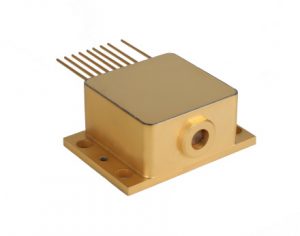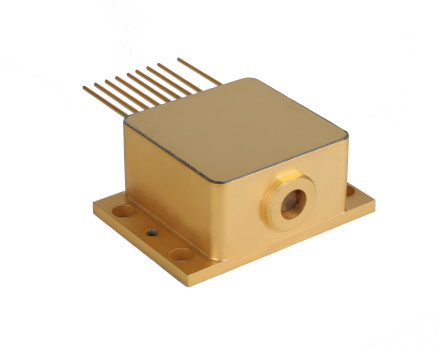UniMir
Quantum Cascade Laser (QCL), Wavelength Stabilized, 10-17um, up to 20mW
Key Features:
- DFB Single-Mode QCL
- Wavelengths: 10-17µm
- Tunable wavelength range within a few wavenumbers
- HHL package with collimation lens
- ≈ 5-20 mW CW output power
- Pulsed operation available
- Mode-Hop-Free tuning range
- > 25dB side mode suppression ratio
- <100MHz linewidth
- <10mrad divergence
- TEM00 beam quality
There are many different package types, wavelengths, output powers, and options to choose from. Get help selecting the right configuration for you!
POPULAR CONFIGURATIONS:
Picture |
Part Number |
Part Description |
Datasheet |
|
|---|---|---|---|---|

|
UN0746C005HNA |
DFB QCL, 13.4um, 5mW, HHL Package w/ TEC, Thermistor, and Collimating lens |
|
Get Quote |

|
UN0713C005HNA |
DFB QCL, 14.0um, 5mW, HHL Package w/ TEC, Thermistor, and Collimating lens |
|
Get Quote |

|
UN0674C005HNA |
DFB QCL, 14.9um, 5mW, HHL Package w/ TEC, Thermistor, and Collimating lens |
|
Get Quote |

|
UN0628C003HNA |
DFB QCL, 16.0um, 3mW, HHL Package w/ TEC, Thermistor, and Collimating lens |
|
Get Quote |
The uniMir Series is a long-wavelength, single-frequency, DFB, CW Quantum Cascade Laser based on proprietary technology. The technology’s versatility allows them to address various wavelengths between ≈ 10um and 17um. Now commercially available in a sealed High Heat Load (HHL) package, with integrated collimating lens, thermistor, and thermoelectric cooler (TEC), well suited for integration into systems, or as a stand-alone turnkey system for R&D and detection applications.
The uniMir series is well suited for integration into systems, or as a stand-alone turnkey system for R&D and detection applications. The technology’s versatility allows them to address any wavelength between 10 and 18µm in CW and up to 21µm in pulsed mode, opening the way for high-resolution spectroscopy applications in this spectral range, notably for the detection of BTEX, but also CH3I, HCN and many other compounds. With very tight linewidths, the uniMir series provides high sensitivity for gas detection, while low power consumption ensures long battery life in portable analyzers.
The uniMir lasers are mounted on a thermoelectric cooler (TEC) inside a sealed High Heat Load (HHL) package, integrating a collimation lens and a thermistor to read out the laser chip temperature. By controlling the chip’s operating temperature through the TEC element inside the laser’s package, customers can tune the emission wavelength without mode hopping while keeping a single-mode operation. The lasers operate in both continuous-wave (CW) and pulsed modes, with the latter providing a larger tuning range and minimal intrapulse linewidth broadening at these long wavelengths.
Perfect for measuring CH3i in the nuclear industry, this UniMir model is a single-mode DFB QCL, operating in CW mode with 10mW output power (with the base plate of the HHL package at 20oC). The full tunable range is >3cm-1, while the continuous tuning range, free from ‘mode hopping’ is >1cm-1.
These benefits make the uniMir laser family an excellent choice for gas analysis in challenging environments, offering mW levels of output power and stable performance over time, with good Allan deviation results when integrated inside a gas analyzer.
- Perfect for measuring CH3i in the nuclear industry, the UniMir at 11.3µm (885 cm-1) is a single-mode DFB QCL, operating in CW mode with 10mW output power (with the base plate of the HHL package at 20oC).
- Perfect for measuring xylene and propane monitoring, the UniMir at 13.4µm (746 cm-1) is a single-mode DFB QCL, operating in CW mode with 5mW output power (with the base plate of the HHL package at 20oC).
- Perfect for hydrogen cyanide (HCN) monitoring, the UniMir at 14µm (713 cm-1) is a single-mode DFB QCL, operating in CW mode with 5mW output power (with the base plate of the HHL package at 20oC).
Combustion Diagnostics: UCLA’s Quantum Cascade Laser Advancements in OH Radical Sensing
MWIR & LWIR QCLs Enable Efficient & Cost-Effective Material Characterization
HHL Package
For clients who wish to purchase only the laser without the driving electronics, all of our laser wavelengths are available in a packaged version alone. Our standard offer is in an HHL package including the thermal regulation and a collimating lens. We are used to developing and supplying custom packages as well. For specific projects, mirSense can also supply QCL chips on submounts on demand.
HHL Features:
- Standard high heat loads package (9-pins HHL) or custom package on request
- Integrated Peltier TEC cooler
- Integrated collimating lens (High beam quality, M²<1.5)
- Possibility of chips on submount delivery
- Optional circular beam with 2.5mrad divergence
Benefits:
- Gas Sensing Benefits:
- Very tight linewidth that drives the very high sensitivity of gas sensing
- Low power consumption for integration in portable gas analyzers
- Very stable over time with good Allan deviation results when integrated inside a gas analyzer
- Operation Benefits:
- CW operation delivering mW levels of output power at room temperature
- Pulsed operation for larger tuning range is a good option because at these long wavelengths, the intrapulse linewidth broadening is relatively small
- Single-mode, mode-hop-free tunability – Controlling operating temperature with TEC enables wavelength tuning without mode hopping while keeping a single-mode operation
If you have any questions or need more information, please contact us.
| Wavelength (nm) | |
|---|---|
| Description | Quantum Cascade Laser (QCL), Wavelength Stabilized, 10-17um, up to 20mW |
| Type |

 SHIPS TODAY
SHIPS TODAY 


